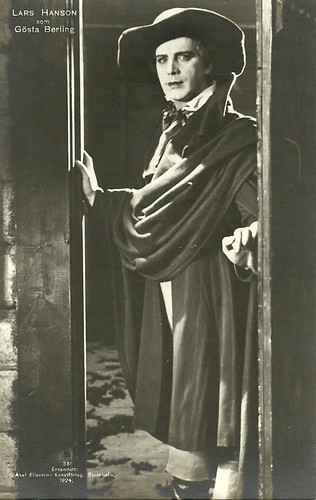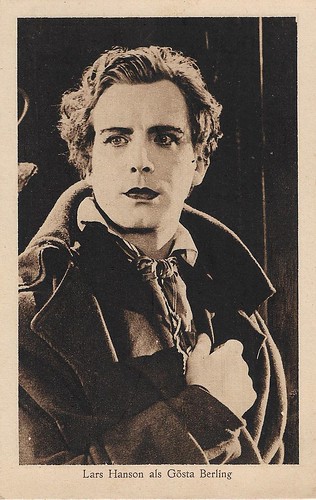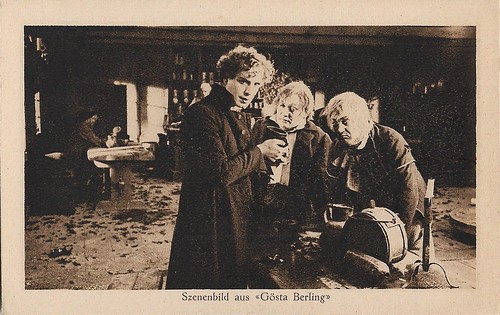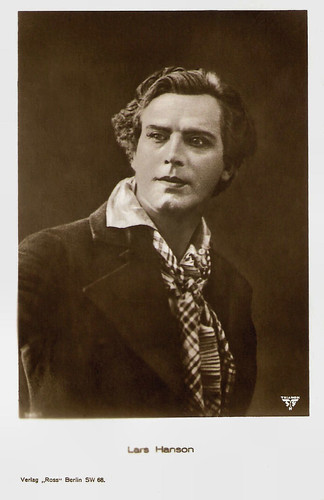
Swedish postcard by Förlag Nordisk Konst, Stockholm, no. 1286. Photo: Goodwin, 1924. Lars Hanson as Gösta Berling in Gösta Berlings saga/The Atonement of Gösta Berling (Mauritz Stiller, 1924).

Swedish postcard by Axel Eliassons Förlag, Stockholm, no. 379, 1924. Photo: Svenska-Film. Mona Mårtenson as Ebba Dolna in Gösta Berlings saga/The Atonement of Gosta Berling (Mauritz Stiller, 1924).

Swedish postcard by Axel Eliassons Konstförlag, Stockholm, no. 381. Lars Hanson as the title character in Gösta Berlings saga/The Atonement of Gosta Berling (Mauritz Stiller 1924).
A novel out of the stories and people of her homeland
'Gösta Berlings Saga' is the first novel by the Swedish writer Selma Lagerlöf. The book was first published in 1891 by Albert Bonniers Förlag in Stockholm.
In Gösta Berling, Selma Lagerlöf is a romantic; the book is a reaction to the realism that prevailed at the time. As a child, she had absorbed the folk tales of her surroundings, and in the autumn of 1881, while walking down the street in Stockholm, she suddenly had the idea of making a novel out of the stories and people of her homeland. Thus the idea for 'Gösta Berlings Saga' was born.
In the summer of 1890, a Swedish magazine, Idun, organised a novella competition and offered a prize for the best novel of a certain length. Lagerlöf entered the contest with five chapters of 'Gösta Berlings Saga', a story that was then beginning to take shape in her mind. She won the competition.
In 1891 the complete novel was finally published. It is set in Värmland in the 1820s and is about the deposed Lutheran vicar Gösta Berling, who becomes the leader of the cavaliers at Ekeby. The adventurous lives of these cavaliers, former officers and impoverished noblemen who have found a freehold on the Ekeby estate and spend their days in love adventures, making music, playing cards and similar amusements, are presented in numerous quite independent chapters.
The story of Gösta Berling, who is purified into a better person after various experiences, forms the framework for a series of rather loosely connected episodes. The reviews were initially negative, with conservative and liberal critics united in their disapproval. Sales were also poor. It was not until 1893, when the well-known Danish literary critic Georg Brandes published an extraordinarily positive review of the Danish translation, that the assessment of the novel changed.
Over time, the success of Gösta Berling grew more and more, and today it is one of the best-known and most widely read Swedish books. 'Gösta Berlings Saga' has been called the epic prose of Swedish rural life. In 1924, the book was filmed, starring the then unknown Greta Garbo, and the popular actors Lars Hanson and Gerda Lundequist.

German postcard by Trianon for the German premiere of the film on 20 August 1924, at the Berlin Theater am Nollendorfplatz. Photo: Svenska Film of the Trianon-Film-Konzern, Berlin (also in Leipzig, Frankfurt a.M., Düsseldorf and Hamburg). Lars Hanson in Gösta Berlings saga/The Atonement of Gösta Berling (Mauritz Stiller, 1924).

German postcard by Trianon for the German premiere of the film on 20 August 1924, at the Berlin Theater am Nollendorfplatz. Photo: Svenska Film of the Trianon-Film-Konzern, Berlin (also in Leipzig, Frankfurt a.M., Düsseldorf and Hamburg). Gerda Lundequist as the Major's Wife and Lady of the Estate Ekeby, Margaretha Samzelius, in Gösta Berlings saga/The Atonement of Gösta Berling (Mauritz Stiller, 1924).

German postcard by Trianon-Film, 1924. Photo: Svenska-Film. Karin Swanström, Sixten Malmerfelt and Jenny Hasselqvist in Gösta Berlings saga/The Atonement of Gosta Berling (Mauritz Stiller, 1924).
The last great masterpiece of Swedish silent cinema
The film adaptation, Gösta Berlings saga/The Saga of Gösta Berling (Mauritz Stiller, 1924), premiered in two parts in Stockholm on 10 and 17 March 1924. Lars Hanson played the young priest Gösta Berling, who suffers a crisis of meaning in the Swedish countryside around 1820. Emotionally unstable, at the beginning of the plot Gösta Berling is completely a slave to his lusts and gives in to drunkenness and womanising.
After a scandal, he leaves the parish in the dead of night to wander the countryside as a good-for-nothing. With a bunch of other drifters, he comes to Ekeby, the castle of the rich Major Samzelius and his wife (Gerda Lundequist). There he meets the innocent Countess Elisabeth Dohna (Greta Garbo), who helps Gösta to find inner strength and strength of character. Before the two of them can begin a future together, they have to go through many adventures, such as the burning of Ekeby Castle, set by the mad Major Samzelius (Otto Elg-Lundberg).
Gösta Berlings saga/The Atonement of Gösta Berling ended the Swedish creative period of director Mauritz Stiller. Stiller's forte was elegantly staged relationship comedies like Erotikon (1920), but his greatest commercial successes came with opulent literary adaptations. Among them were two works by Swedish author Selma Lagerlöf, Herr Arnes pengar/Sir Arne's Treasure from 1919 and Gunnar Hedes saga/Snowbound from 1923.
The young Greta Gustafson was given the opportunity in the late spring of 1923 to participate in a casting for the upcoming of Stiller's film adaptation Gösta Berlings saga/The Atonement of Gösta Berling, together with her colleague Mona Mårtenson. Stiller discovered a performing quality in the girl, who was only seventeen at the time, that prompted him to give her the important role of Countess Elisabeth.
Shortly after the extensive filming began, Stiller also arranged for the young woman to adopt the stage name Greta Garbo. There are various versions of how the choice came about, the simplest being that the name Garbo was a development of the original suggestion Mona Gabor, which was based on the phonetic sound of a former prince of Transylvania. The actress officially adopted the name Greta Garbo on 9 November 1923.
The shooting, which lasted almost a whole year, was an ordeal for the completely inexperienced actress. Stiller, who as a director was equally a perfectionist and an autocratic ruler, forced Greta Garbo to unconditional obedience to his instructions. Through endless repetitions of individual scenes and targeted verbal attacks, he steered Greta Garbo in the direction he had intended from the beginning. Garbo gave herself completely into the hands of her mentor and finally accepted without complaint the sometimes violent insults when, in Stiller's opinion, she had not given her best performance.
After the film was shot, Mauritz Stiller went to Hollywood via Berlin together with his protégée Garbo. Gösta Berlings saga/The Atonement of Gösta Berling (Mauritz Stiller, 1924) is today considered the last great masterpiece of Swedish silent cinema. The spectacular fire at Ekeby Castle was the most expensive sequence ever filmed in Sweden at the time. Stiller used the entire technical repertoire, such as rapid editing sequences and lighting effects, to bring the drama of the action to the screen. Another well-known shot showed Elisabeth Dohna fleeing in her horse-drawn sleigh in frantic flight across a frozen lake from a pack of wolves. However, Stiller used specially trained German shepherds for the sequence, hanging weights on their tails so that they would show the typical posture of wolves in the 'longshots'.
The film was originally released in two parts in Sweden, Gösta Berlings saga del I on 10 March 1924, and Gösta Berlings saga del II seven days later. The two-part version was also released in Finland and Norway, but for the rest of the world a shorter, one-part export version was made. In 1927 the film was recut, almost halving its running time. This was the only version that was archived. In 1933 a sound version was released theatrically in Stockholm, with the intertitles removed, along with additional edits and some reordering of the scenes. Most of the missing material was discovered 20 years later and a restored version with new intertitles was released in theatres. The Swedish Film Institute added newly found fragments throughout the years, but as of the 1975 restoration about 450 metres of film from the original cut remained missing. In February 2018, the completion of a new, comprehensive restoration was announced. The 2018 version is 16 minutes longer than the previous restoration and brings the film close to its original running time. It also restores the film's tinting scheme for the first time since its original release.

German postcard by Trianon-Film, 1924. Photo: Svenska-Film. Mona Mårtenson in Gösta Berlings saga/The Atonement of Gosta Berling (Mauritz Stiller, 1924), based on the novel by Selma Lagerlöf.

German postcard by Trianon for the German premiere of the film on 20 August 1924, at the Berlin Theater am Nollendorfplatz. Photo: Svenska Film of the Trianon-Film-Konzern, Berlin (also in Leipzig, Frankfurt a.M., Düsseldorf and Hamburg). Lars Hanson as Gösta Berling in Gösta Berlings saga/The Atonement of Gösta Berling (Mauritz Stiller, 1924).

German postcard by Trianon for the German premiere of the film on 20 August 1924, at the Berlin Theater am Nollendorfplatz. Photo: Svenska Film of the Trianon-Film-Konzern, Berlin (also in Leipzig, Frankfurt a.M., Düsseldorf and Hamburg). Lars Hanson in Gösta Berlings saga/The Atonement of Gösta Berling (Mauritz Stiller, 1924).

German postcard by Ross-Verlag, Berlin. Photo: Trianon. Lars Hanson in Gösta Berlings saga/The Atonement of Gösta Berling (Mauritz Stiller 1924).
Sources: Wikipedia (German and English) and IMDb.
No comments:
Post a Comment